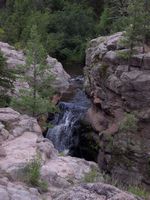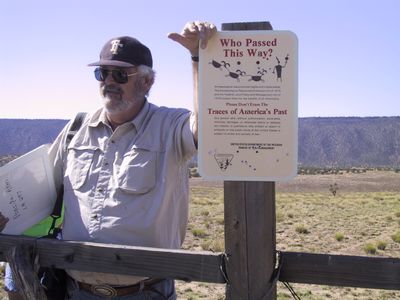|
2012 Field Work Committee Activities include the following
Remember in November of last year, when Frank Oatman presented a report of a lithic survey at the La Junta quarry site done by Dr. Robert Dello-Russo and members of the Society? Dr. Dello-Russo asked the organization to support the XRF testing of the lithics for a total cost of $350. Members were asked to contact Frank for information on how to submit their donation so the contribution will reach the Office of Archaeological Studies to be applied to the project. Gary Grief indicated that the OAS had provided several speakers to TAS over the last few years at not cost and that there funding was so short that they had been unable to move into their new building for over a year. Paul Williams added that the XRF testing would be a very useful thing to support as it applied directly to studies of important archaeological sites in Taos County. As a "Thank You" from Dr. Dello-Russo for the financial support he received from individual TAS members to pay for this testing, you will find attached the laboratory report provided to him, submitted by Steve Shackley at the Berkeley Archaeological XRF Lab, on the XRF analysis of the "dacite" samples we recovered from the La Junta site and from the "Oatman" quarry location. As you can see in the report, the materials at the La Junta site appear to be the same - geochemically - as those that come from the Newman Dome source area to the northwest of the site; and the materials at the Oatman quarry location appear to be unique - not matching any other previously characterized source areas (at least in Shackley's data base). This report will be incorporated, eventually, into a short field report for the BLM outlining our findings at - and redocumentation of - the La Junta site. The Taos Archaeological Society has many different ongoing field projects and is always looking for friends interested in joining the fun. |
|||
|
|
|||
SiteWatch Project TAS has a team of volunteer Site Stewards to help monitor and protect some of the wonderful cultural resources found here in the Upper Rio Grande area. We're working closely with the BLM and the Carson National. The BLM has identified about 20 sites that are "at risk" to vandalism or natural damage, and BLM archaeologist Paul Williams is taking the entire team out to each of the sites for an overview of what those risks might be. The list is a mix of Pueblo and petroglyph sites and we all feel honored to be able to visit some areas that are not well known, but of great cultural value. As the list of sites in need of monitoring grows, we also need to grow our list of volunteers. This program is open to anyone who has an interest in the preservation of archaeological sites, historic buildings, and other cultural resources and is willing to abide by the Stewards' Code of Conduct. To become a NM SiteWatch Site Steward, an individual must submit an application and agreement form (subject to background check), and complete the "Introduction/Orientation to Site Stewardship" class. Why is this program important?
From the New Mexico Site Steward Handbook: Our State is special. Our people, land, and history come together to create a truly unique place that we are proud to call home and which others are excited to visit. Due to a combination of dry climate, low population density, and unique history, New Mexico is blessed with thousands of cultural resources that remain in extraordinary condition. However, New Mexico is not immune to the pressures of development, increased access, and the significant growth in the illegal market for prehistoric antiquities. Single Mimbres pottery vessels are sold for more than many of our citizens might make in a year. The result has been the willful destruction of our state's special heritage.
SiteWatch is a statewide volunteer program coordinated by the State Historic Preservation Division and funded by public and private partnerships. New Mexico's cultural heritage is essential to our state and nation's knowledge and quality of life. SiteWatch seeks to conserve and protect cultural properties by coordinating the efforts of New Mexico's citizens and landowners as they serve as stewards and educational docents of their own cultural resources. By reducing the degradation of cultural treasures due to vandalism, theft, and natural processes through monitoring and education, SiteWatch ensures that irreplaceable heritage resources can be appreciated by current and future generations of New Mexicans. |



